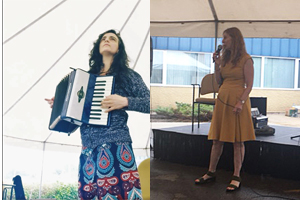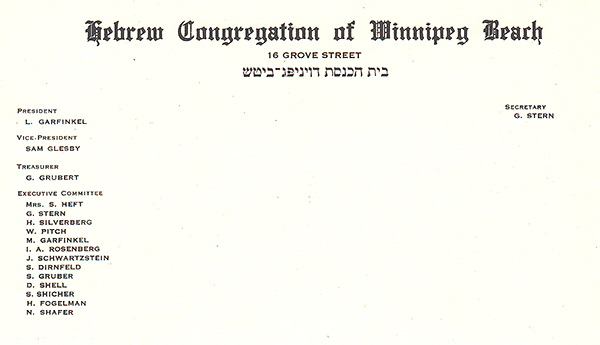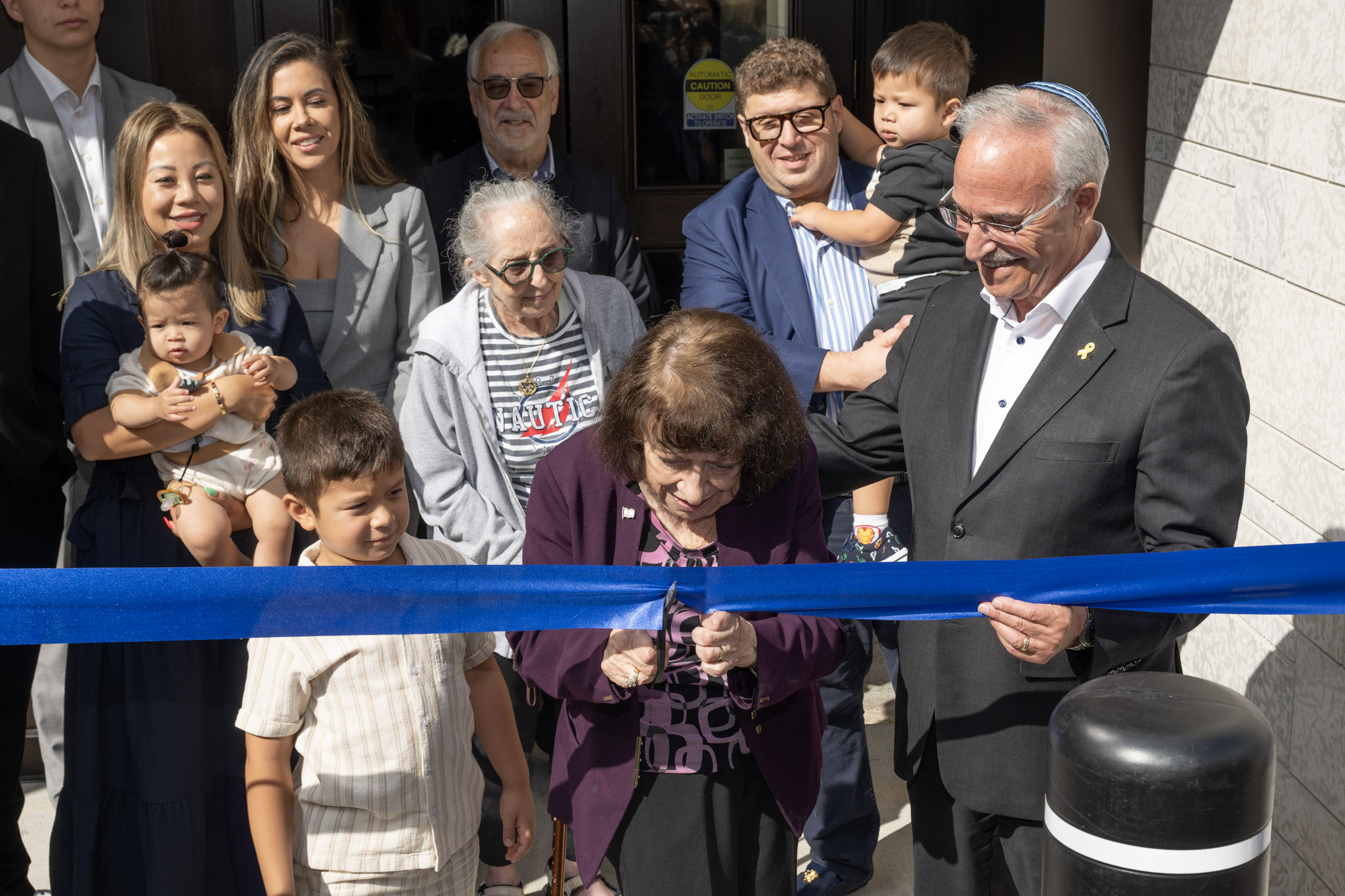Local News
Gwen Secter Centre plays host to Canadian/Israeli singer/songwriter of considerable renown who was stranded in Winnipeg for over a year and a half

By BERNIE BELLAN After going a year and a half in Winnipeg without any live entertainment to speak of – beyond the occasional street concerts that seemed to spring up impromptu from time to time, it was welcome news to read that the Gwen Secter Centre was going to be playing host to a series of weekly concerts every Wednesday through August 25th.
While there have been plenty of Zoom concerts that have attempted to fill the void, there’s nothing like having an audience on hand to watch and hear real live performers.
Thanks to the irrepressible Karla Berbrayer, our community’s incomparable impresario, along with Gwen Secter’s dynamic executive directory, Becky Chisick, a variety of performers – almost all of whom are Winnipeggers, were booked to perform two shows each Wednesday – at 11 and then again at 1.
When I scanned the names of the featured artists, however, one name caught my eye, as I had never heard of her: Orit Shimoni. In our July 21 issue she was described as an “Israeli Canadian” who was going to “accompany herself on guitar and accordion in a solo performance.”
Was she one of the many Israeli newcomers who have arrived in Winnipeg in recent years, I wondered?
The answer was quite different, I soon learned. Orit is a singer and songwriter of considerable renown who has actually recorded 11 different albums – some in English, some in Hebrew.
Here’s some information about Orit taken from her own website: “Raised in both Calgary and Jerusalem, the then Montrealer had released her debut album (Cinematic Way, 2006) with the help of local musicians and producer Mark Goodwin, and the response to it, including Mark Rheaume of CBC radio calling it one of the top 3 albums of its year, alongside Feist and Arcade Fire, led Shimoni to believe that her musical path was not just a pipedream.
“Knowing very little about the industry, she set off on an outside-of-the-box, self-managed DIY adventure that brought her to Berlin for a year, and after that, a decade of living out of a suitcase, performing across Canada and Europe entirely by public transit, in cafes, pubs, bars, reputable venues, house concerts, small festivals, and on Via Rail’s on-board entertainment program. As she traveled, she received numerous recording offers and has released eleven albums in total, with more on the way.”
So, how did Orit end up, not only coming to Winnipeg – which was in March, 2020, she told me, she ended up staying here for 16 months (and perhaps longer, depending on how quickly things open up in other provinces)?
It turns out she was on a Via Rail train (performing along the way, in a program that affords musical artists the chance to travel from one city to another while entertaining passengers along the way – sort of reminds me of Mexican buses where entertainers hop on and off, playing for tips from passengers). When the train, which had originated in Vancouver, and with a stop in Edmonton, hit Winnipeg that fateful day in March/20, it was Orit’s lousy luck to find herself stranded just as this province was entering into shutdown mode.
“When I arrived in Winnipeg I got a text message saying my next train out of town has been canceled,” Orit explained.
She was stuck here – and even though she managed to find accommodation with an acquaintance whom she had known previously, her live performing career came to a complete standstill – similar to every other live performer.
While she did manage to write and record new songs during her long hiatus from performing, Orit says she so dearly missed playing in front of live audiences.
Now, anyone who knows Karla Berbrayer would know that she’s constantly on the hunt for new talent, especially Jewish performers who can sing in Hebrew. When word reached Karla that a very talented Israeli Canadian was living in our midst, Karla didn’t hesitate to make contact with Orit. Thus – her July 21st appearance at Gwen Secter.
While the crowd that particular morning might have been small in size (even at its maximum, the nicely constructed canopy-covered Gwen Secter venue – on the centre’s parking lot, can only hold 25 people for a performance).
I arrived a few minutes before 11 that day – and there wasn’t anyone else in the audience at all – which afforded me the opportunity to go up to Orit and introduce myself.
Seeing Karla Berbrayer there as well, I asked Karla what would happen if no one showed up? “Don’t worry,” Karla assured me, “there are people who are arriving in special transport.”
Sure enough, attendees started to arrive. I’m not sure anyone reading this can remember, but July 21 was also the last day we had any significant rain in Winnipeg, and no doubt the possibility of getting soaked was a deterrent for some who might have considered attending Orit’s concert. (As it turned out, there was some rain prior to the concert, but the canopy was absolutely effective in keeping the seating area dry.)
Once Orit began to perform, I was astonished how beautiful her voice was. She opened her concert with a lovely rendition of “Hinei ma tov u ma na’im”, accompanying herself on the accordion. She followed that with a number of famous American folk songs, including “Blowing in the Wind”. Later in the concert she switched to playing guitar – and judging by the look of that particular guitar, with its noticeable chip in the wood, it has seen better days.
While I would have wished that Orit had told a little bit more about herself in between her songs, she preferred to talk only about how she ended up in Winnipeg. I had to learn, after reading biographical notes on her website, that Orit used to be a teacher and academic (with a master’s degree in theological studies).
What a shame that Orit wasn’t able to play in front of a much larger audience that July day. Perhaps we’ll get the chance to see her again – assuming that she’ll want to fulfill the original goal of playing at a number of venues when she arrived her that fateful day in March, 2020.
In the meantime if you want to hear samples of Orit’s singing, she has a number of songs from her latest album available to hear on her website: https://www.oritshimoni.com/
Local News
Thank you to the community from the Chesed Shel Emes

We’re delighted to share a major milestone in our Capital Campaign, “Building on our Tradition.” Launched in November 2018, this campaign aimed to replace our outdated facility with a modern space tailored to our unique needs. Our new building is designed with ritual at its core, featuring ample preparation space, Shomer space, and storage, creating a warm and welcoming environment for our community during times of need.
We’re grateful to the nearly 1,000 generous donors who contributed over $4 million towards our new facility. A $750,000 mortgage will be retired in November 2025, completing this monumental project in just seven years.
We’re also thrilled to announce that our Chesed Shel Emes Endowment Fund has grown tenfold, from $15,000 to $150,000, thanks to you, the Jewish Foundation of Manitoba’s FundMatch program, and Million Dollar Match initiative in 2024. Our fund helps ensure that everyone can have a dignified Jewish funeral regardless of financial need.
As we look to the future, our goal remains to ensure the Chevra Kadisha continues to serve our community for generations to come. Our focus now shifts to replenishing our savings account and growing our JFM Endowment fund.
We’re deeply grateful for your support over the past several years.
It’s our privilege to serve our community with care and compassion.
With sincere appreciation,
Campaign cabinet: Hillel Kravetsky, Gerry Pritchard, Stuart Pudavick,
Jack Solomon, and Rena Boroditsky
Murray S. Greenfield, President
Local News
Winnipeg Beach Synagogue about to celebrate 75th anniversary

By BERNIE BELLAN (July 13) In 1950 a group of cottage owners at Winnipeg Beach took it upon themselves to relocate a one-room schoolhouse that was in the Beausejour area to Winnipeg Beach where it became the beach synagogue at the corner of Hazel and Grove.
There it stayed until 1998 when it was moved to its current location at Camp Massad.
On August 2nd members of the synagogue will be holding a 75th anniversary celebration.

As part of the celebration anyone who is a descendant or relative of any of the original members of the first executive committee (as seen in the photo here) is invited to attend the synagogue that morning.
If you are a relative please contact Abe Borzykowski at wpgbeachshule@shaw.ca or aborzykowski@shaw.ca to let Abe know you might be attending or for more information about the 75th anniversary celebration.
We will soon be publishing a story about the history of the beach synagogue, which is something I’ve been writing about for over 25 years.
Local News
Vickar Family cuts ribbon on new Tova Vickar and Family Childcare Centre

By MYRON LOVE In the words of Larry Vickar, the Shaarey Zedek’s successful Dor V’ Dor Campaign “is not only a renewal of the synagogue but truly a renewal movement of Jewish life in our community.”An integral part of that renewal movement was the creation of a daycare centre within the expanded synagogue. On Monday, June 23, Larry and Tova Vickar cut the ribbon, thereby officially opening the Tova Vickar and Family Childcare Centre in the presence of 100 of their family members, friends and other supporters of the project.
The short program preceding the morning ribbon-cutting began with a continental breakfast followed by a welcome by both Fanny Levy, Shaarey Zedek’s Board President, and Executive Director Dr. Rena Secter Elbaze. In Elbaze’s remarks, she noted that Larry and Tova wanted their family (including son Stephen and family, who flew in from Florida) and friends at the event to celebrate the opening of the Tova Vickar and Family Childcare Centre, “not because of the accolades, but because, as Larry put it, he hopes that their investment in the congregation will inspire others to do the same.”
“When Larry and I spoke about what this gift meant to him and the message he wanted people to take away,” she continued, “I couldn’t help but connect it to the teachings of Reb Zalman Schachter-Shalomi whose book – Age-ing to Sage-ing – changes the whole way we look at the concept of ageing and basing it on our ancestral teachings.”
She explained that his concept of “Sage-ing” is based on three key ideas – Discover your meaning and purpose; accept our mortality and think about the legacy you want to leave.
“Larry spoke about these exact concepts when we met,” she said.
Elbaze also noted the presence of Shaarey Zedek’s newly-arrived senior Rabbi Carnie Rose, former Rabbi Alan Green, and area MLAs Mike Moroz and Carla Compton.
Larry Vickar expressed his great appreciation for all those in attendance. “Tova and I are deeply moved to stand here with you today for this important milestone in our community”, he said. “We are grateful to be surrounded by all of you, the people we care about, our family and friends… you who have touched our lives and played some part in our journey.”
